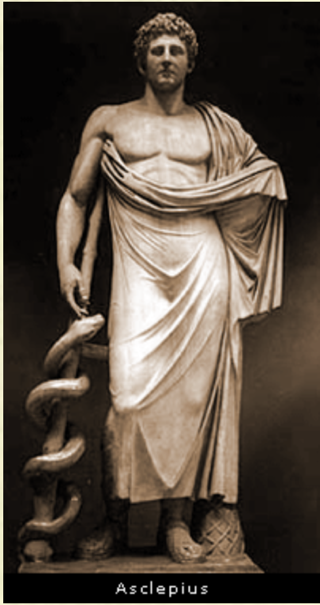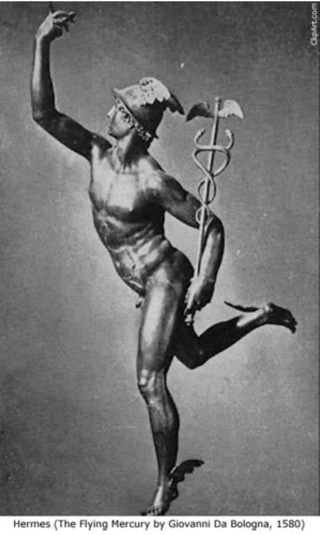CADUCEUS
—————————————————
ABSTRACT: There are two basic caduceuses used to represent the U.S. medical profession. It appears that one has historical medical relevance and the other does not. The caduceus with medical relevance is that of Asclepius, the Greco-Roman god of medicine. The caduceus that appears to have no medical relevance is that of Hermes/Mercury the Greco-Roman god of commerce, messenger for the Olympian gods and the one who lead the dead to Hades. Thus the medical caduceus appears to be Asclepius’ single snake wrapped around a walking stick and not the caduceus with two snakes intertwined with wings atop representing Hermes/Mercury. This latter use appears to have first occurred when the U.S. Armed Forces chose the Hermes’/ Mercury’s caduceus for the insigne of the Medical Corps. instead of Asclepius’ caduceus. Much of the medical profession continues to carry on this tradition as they go about choosing there insignia. A full discussion follows.
—————————————————
The caduceus with its winged staff and intertwined serpents, frequently used as a medical emblem, appears to be without medical relevance since it represents the magic wand of the Greek god named Hermes or Mercury, the messenger of the gods and the patron of trade, rather than Asclepius the god of medicine. This god of merchandise was called Mercury by the Romans, (derived from the Roman word for merchandizing, Mercurius), and Hermes by the Greeks, (derived from a Greek root related to merchandizing, Merx). Since Mercury was the god of commerce, the caduceus is sometimes used today as a symbol of trade. Caduceus is a Latan loanword, Greek karykeion from karyx (“herald”). The change of “r” to “d” may originate in an idea that the word had something to do with cadere, caduceus “to fall,” “fallen”. Hermes used the herald’s wand to conducted the dead to the Underworld, Hades. Hermes was the son of Zeus and Maia, daughter of Atlas. He began his career by escaping from his cradle, when a few hours old, and going out in search of adventures. Finding a tortoise, he took the shell and stretched cords across it, thus inventing the lyre. That same evening he stole the oxen of Apollo, god of the sun, hid them in a cave, and killed two of the oxen. When Apollo discovered the theft, Hermes charmed Apollo by playing on the lyre, and Apollo allowed the little rogue to go unpunished. Hermes gave his lyre to Apollo and received in return a magic wand, called the caduceus. He was made the messenger of the Olympian deities, and one of his many duties was to conduct the shades of the dead to the netherworld. Among men Mercury became the patron of merchants, the god of eloquence, of good fortune, of prudence and cunning, of fraud and theft. He was also regarded as the god of the roads and the protector of travelers. The Romans considered Mercury rather crafty and deceptive, and even as being a trickster or thief. Criminals regarded him as their protector. Mercury’s caduceus had snakes curled around it to protect him on his travels. Originally the caduceus was a rod or olive branch ending in two shoots and decorated with garlands of ribbons. Later the garlands were interpreted as two snakes entwined in opposite directions with their heads facing; and a pair of wings, in token of Mercury’s speed, was attached to the staff above the snakes. According to Apollo, the staff had the power to unite all beings divided by hate. When Hermes came to Arcadia, he saw two serpents fighting; he threw the staff between them, and the snakes wound themselves around it in friendly association. The caduceus is a symbol of peace, prosperity, and commerce. The rod represents power; the serpents represent unity and wisdom; and the two wings, speed, diligence and activity. Its similarity to the staff of Asclepius, the Greek god of Medicine (a staff entwined by a single serpent) resulted in the adoption of Hermes’/Mercury’s caduceus as a symbol of the U.S. physician by the U.S. Army Medical Corps. This symbol continued to spread throughout many of the healthcare professions as they went about choosing insignia.
The caduceus, with a single snake coiled around it, came to be a symbol for Asclepius, the god of medicine. Asclepius the Greco-Roman god of medicine, was the son of Apollo (god of healing, truth, and prophecy) and the nymph Coronis (the princess of Thessaly). When Coronis proved unfaithful to Apollo, either Apollo or Artemis killed her. Her unborn child, Asclepius, was extracted from his mother’s dead body, by Apollo, and sent to the centaur Chiron, who taught him medicine, the art of healing. Asclepius, when grown, became so skilled in surgery and the use of medicinal plants that he could even restore the dead to life. Hades, ruler of the dead, became alarmed at this and complained to Zeus. Zeus, infuriated that another should have such power, slew him with a thunderbolt and sent him to Hades. Epidaurus in Greece was the special site of his followers, the Asclepiads, the first physicians who apparently were not in agreement with the Hippocratic physicians as the Hippocratic group did not believe that physicians should do any cutting, i.e. surgery. Asclepius’ cult became important from the late fifth century B.C.. First he was honored as a hero—for example, at Athens—and eventually worshiped as a god. Many temples were erected to Asclepius. The practice of sleeping in these sanctuaries was very common, it being supposed that the god effected cures or prescribed remedies to the sick in dreams. All who were healed offered sacrifice (especially a cock), and many tablets recording their names, their diseases and the manner in which they had been cured, have been discovered at Epidaurus, the god’s most famous shrine. The cult was introduced to Rome by order of the Sibylline books (293 B.C.) to relieve a pestilence. Asclepius’ temple stood on Tiber island, (its site being now occupied by the hospital of St. Bartholomew). A delegation sent to fetch the image of the god from Epidaurus returned bringing instead a snake in which the god was thought to reside. Harmless snakes were then kept in Asclepius’ temples. The symbol of Asclepius was the staff (power and authority) and the snake, (Asclepias presence represented by how the snake could shed its skin and appear young again and by the healing power that was believed to be in the snake’s tongue).
Thus the staff with its single serpent appears to be the more historical symbol of medicine. The caduceus with its winged staff and intertwined serpents, which is frequently used in the U.S. as a medical emblem, is apparently without without medical relevance since it represents the magic wand of Hermes or Mercury, the messenger of the gods and the patron of trade and not the medical god of Asclepius.




